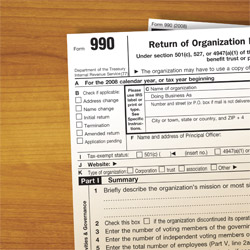
Good governance policies are normally considered part of the for-profit environment. However, the Internal Revenue Service has issued several recommendations related to good governance and new regulations for charitable-entity employee benefit plans, or Section 403(b) plans. These new rules and recommendations affect virtually every tax-exempt entity, and the changes should be adopted by your organization by the end of this calendar year.
Employee Benefit Plans
Certain tax-exempt entities are allowed to adopt a Section 403(b) plan, similar to the 401(k) plan offered by many for-profit entities. In the past, the IRS has not governed these plans with strict requirements. As of December 31, 2008, if your entity has a 403(b) plan, certain requirements must be met in order to continue to defer employees’ salaries.
The regulations provide guidance for 403(b) contracts for public schools and tax-exempt organizations described in Section 501(c)(3), as well as certain church employees and ministers. Due to the significant changes in the new regulations, listed below are some issues that should be considered immediately regarding how these regulations will affect your Section 403(b) plan:
- Adopt a written plan that specifies the plan’s provisions by December 31, 2008.
- As part of the plan document, any contracts must list the allocation of responsibilities among the employer, the issuer of the contract and any other party involved in implementing the plan. These duties are not to be allocated to employees.
- The plan must list the contracts available under the plan, an “Approved List.” Therefore, you should identify the vendors to whom you or your employees have made contributions, and obtain copies of the individual contracts or custodial agreements from them. Determine how many vendors will be allowed as part of the plan and whether any vendors should be discontinued.
- Determine how your plan document will be drafted and whether the design should be changed to comply with the new requirements.
Governance
While the IRS has no ability to mandate specific management structures or policies, they do have a belief that organizations with sound governance and board policies are more likely to serve charitable interests than an organization without them. In response to this belief, the 2008 Federal Form 990 has several new questions and information disclosures that will provide insight into the charity’s governance. While not all of the items listed below may be applicable to each organization, they should be considered, as each has a question on the 2008 Form 990.
• All charitable organizations should have a clearly defined mission statement and organization documents. A clearly defined mission statement provides to the public the purpose of the organization, those it serves, goals to be accomplished and how they will be achieved.
- A charitable entity should have an appropriate governing body consisting of individuals actively engaged in the implementation of policies and organization structure. While the size of the governing body varies depending on the size of the entity, it should be large enough to have diversity in opinions and skill sets.
- An organization should consider appropriate policies related to executive compensation, conflict of interest, whistle blowers, investments, fundraising and document retention or destruction policies.
- All organizations should have a governing body with responsibility for the review and accountability related to the financial statements and Form 990. Many organizations will outsource the preparation of the financial statements and Form 990 to outside entities like accounting firms or management companies. However, the responsibility for the accuracy of these reports remains with the organization’s governing body.
- The IRS guidance for charitable entities encourages transparency and accountability. Charitable entities are required to provide to the public their Form 990, 990T, organization documents and application for exempt status (Form 1023). Organizations are encouraged to provide these forms on their websites for ease of public access.
For each of the items listed above, the important first step is recognizing a need to evaluate current policies related to governance and employee benefits. Some of the items will take time to implement, but the process of considering and implementing these standards will strengthen an organization. For additional assistance in understanding these or any other IRS requirements, visit the IRS web site at irs.gov/charities or talk with your accounting professional. iBi

